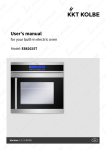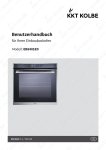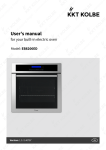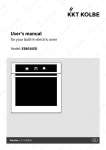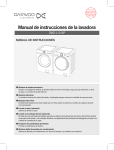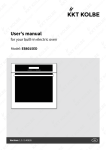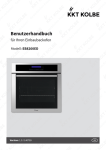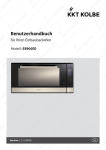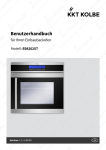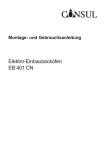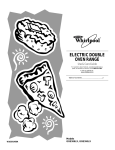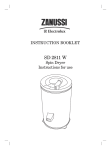Download User's manual - page screenshot of kolbe
Transcript
User’s manual for your built-in electric oven Model: EB8401ED Version: 1.0 / 140707 EN Safety instructions Dispose of the dishwasher packaging material correctly. All packaging materials can be recycled. This icon indicates a hazardous situation. Plastic parts are marked with the standard international abbreviations: (e.g. PS for polystyrene, padding material) Observe these safety instructions and behave accordingly careful. Enter these warnings also to other users of the device. This appliance is identified according to the European guideline 2002/96/EC on waste electrical and electronic equipment -WEEE. The guideline specifies the framework for an EU-wide valid return and re-use of old appliances. You‘ll find it especially with all descriptions of the steps that might cause danger to persons arising. ! This icon indicates a warning. You can find it in the description of the steps that must be observed in order to damage to the unit can be prevented. Please include these safety instructions to all device users. This icon indicates an information. This symbol indicates useful tips and calls attention to proper procedure and behavior. The observance of the notes marked with this icon may save you many problems. 2 Safety precautions Warning • When the oven is first switched on, it may give off an unpleasant smell. This is due to the bonding agent used for the insulating panels within the oven. This is completely normal, if it does occur, you merely have wait for the smell to clear before putting food into the oven. • The appliance and its accessible parts become hot during use. • Care should be taken to avoid touching heating elements. • Children less than 8 years of age shall be kept away unless continuously supervised. • This appliance can be used by children aged from 8 years and above and persons with reduced physical, sensory or mental capabilities or lack of experience and knowledge if they have been given supervision or instruction concerning use of the appliance in a safe way and understand the hazards involved. Children shall not play with the appliance. Cleaning and user maintenance shall not be made by children without supervision. EN ! • Care should be taken to avoid touching heating elements inside the oven. • Do not allow children to go near the oven when it is operating, especially when the grill is on. • Ensure that the appliance is switched off before replacing the oven lamp to avoid the possibility of electric shock. • The means for disconnection must be incorporated in the fixed wiring in accordance with the wiring specifications. • Children should be supervised to ensure that they do not play with the appliance. • This appliance is not intended for use by persons (including children) with reduced physical, sensory or mental capabilities, or lack of experience and knowledge, unless they have been given supervision or instruction concerning use of the appliance by person responsible for their safety. • Do not use harsh abrasive cleaners or sharp metal scrapers to clean the glass of the oven. • This can scratch the surface and may result in permanent damage to the glass. • During use, the appliance becomes very hot. • Do not use harsh abrasive cleaner or sharp metal scrapers to clean the oven door glass since they can damp hands or feet. • For oven: Oven door should not be opened often during the cooking period. • The appliance must be installed by an authorized technician and put into use. The producer is not responsible for any damage that might be caused by defective placement, and installation by unauthorized personnel. • When the door or drawer of oven is open do not leave anything on it, you may unbalance your appliance or break the door. touching onto the points that are exposed to the heat directly. • If you will not use the appliance for a long time, it is advised to plug if off. • If the supply cord is damaged, it must be replaced by qualified persons in order to avoid a hazard. • Excess spillage must be removed before cleaning and shall specify which utensils can be left in the oven during cleaning. • Only use the temperature probe recommended for the oven. • A steam cleaner is not to be used. • Some parts of appliance may keep its heat for a long time; it is required to wait for it to cool down before 3 Thank you! Dear customer, thank you for the trust placed in us and for the purchase of this KKT KOLBE device. Your new appliance is designed for the requirements in yourhousehold. Please read this user’s and instruction manual carefully, which describes the capabilities and operation of your KKT KOLBE-mounted device. This manual is adapted to different types of devices, so it is possible that you can find some descriptions of functions that does not contain your device. For damage to persons or objects caused by faulty or improper installation of the device, the manufacturer accepts no liability. The manufacturer reserves the right to make any necessary modifications to the model types of devices that are used for ease of use and protect the user and the device and correspond to a current technical standards. Your KKT KOLBE team User’s manual Model EB8401ED Version 1.0 © KKT KOLBE. KKT KOLBE is a registred trademark. 4 Table of content 6 2. The oven interior 2.1 Construction 2.2 Telescopic runners 2.3 Device fan 9 3. Application 3.1 Roast 3.2 Grilling & baking 3.3 Baking 3.4 Boiling down 3.5 Unfreezing 3.6 Application table 10 4. Programming 4.1 Setting the clock 4.2 Select type of heating 4.3 Adjust the cooking time 4.4 Delayed start 4.5 Minute minder 4.6 Key lock 12 5. Special features 5.1 Using the core probe 5.2 Temperature overview 14 6. Care and cleaning 5.1 Case front 5.2 SteamClean 5.3 Remove the oven door 5.4 Oven Racks 5.5 Telescopic runners 5.6 Change the oven light bulb 5.7 Oven glass 16 7. Trouble shooting 6.1 Content & Accessoires 6.2 Roasting spit 6.3 Safety switch-off 6.4 What to do in case of problems 17 8. Installation and connection of the device 7.1 Installation in floor cabinet 7.2 Installation in a wall unit 7.3 Power supply 19 9. General information 9.1 Data sheet 23 EN 1. Using the device 1.1 Control panel 1.2 Energy saving tips 1.3 Types of heating / functions 5 Using the device Control panel 1 3 8 2 4 7 5 1. Power-button 2. Oven function 3. Temperature button 4. Display 5. Time options 7. Decrease/Increase 8. Light Energy saving tips • If possible, use dark black finished or silicone-coated enamelled tins, because they absorb the oven heat particularly well. • Only preheat the oven if this is specified in the recipe or in the tables. • When heating up the empty oven, much energy is needed. It can therefore be saved by baking several dishes one after the other energy because the residual heat is used optimally. • Switch off the oven about 10 minutes before the end of longer baking times to use the residual heat to finish cooking. 6 Types of heating Types of heating EN Oven light The oven light may be turned on with no further function. Top heat + convection Default temperature: 190 °C This setting can be used for example if you want on the grid to bake a cake in the upper part of the furnace and eg in the lower part want to bake cookies, which should be well browned and crispy. The top heating elements are in operation and the fan constantly circulates hot air. Before you start baking, you should leave the oven preheat. This system you use for roasting. We recommend the roast temperature to 165 ° C set, here you get an optimal cooking result and stay below the temperature injected in fat. Thus, the device is easy to clean after roasting. Convection Default temperature: 170° An element around the convection fan provides an additional source of heat for convection style cooking. In convenction mode, the fan automatically turns on to improve air circulation within the oven and creates an even heat for cooking. The temperature can be set within the range of 50 – 240 °C. The default temperature is 180 °C. If possible, use this type of heating to cook food on more than one layer. Bottom heat + convection (pizza function) Default temperature: 190 °C The bottom heating + hot air mode is for recipes with a damp pad and a crunchy dough, such as pizza, quiche, fruit and cheesecake. Before you start baking, you should leave the oven preheat. 7 Types of heating Top-/ bottom heat Default Temperature: 200 °C The top and bottom work together to provide convectional cooking. The temperature can be set within the range of 50-250OC. The default temperature is 220OC. This is optional function that can be work with rotisserie motor. Full-width grilling Default Temperature: 240° The inside radiant element and top element are working. The temperature can be set within the range of 180-240°C. The default temperature is 210°C. Grilling Default Temperature: 240 °C The inner grill element switches on and off to maintain temperature. The temperature can be set within the range of 180 – 240 °C. The default temperature is 210 °C. Defrost In this mode only air circulation without heating is turned on. You can use it for gentle defrosting of frozen food. 8 Inside the oven EN Inside the oven 1 Hook-in racks with rack levels 5 4 2 2 1 3 2 6 1 2 Lighting 4 3 Fan with ring heater 3 4 Grill heating element 2 5 Top element 1 6 Bottom heat radiator (under the oven floor) 1 to 4 : Shelf levels for shelf unit, baking tray or roasting pan. Please note that the numbering of the rack levels from bottom to top. Door contact switch Connection of core temperature probe Catalytic side wall (optional) oven light shelf levels Telescopic runners (optional) ! Telescopic drawer slides and other accessories become hot. Use potholders! The oven has hook-in racks with telescopic slide rails on 2 or 3 levels (depending on model). Case cooler The case cooling ensures low temperatures on control panel, switch knob and the oven door handle in heated oven. The case cooling is turned on when a heating mode is set. The air exits between the oven door and control panel. • For onset of rust, baking sheet or roasting pan first pull out the telescopic drawer slides one level. • Store shelf unit, baking tray or roasting pan on the drawnout rails and push it by hand entirely in the oven until it stops. The oven door always closes only when the telescopic slide rails are fully inserted. 9 Application Roasting Baking For roasting the top and bottom heat or hot air can be used. For baking, the top and bottom or the hot air may be used. If in the baking table no special pastries types are specified, select the information to a similar pastry or cake. • Tableware made of enamel, fire resistant glass, clay (clay pot) or cast iron use. • Are unfavorable Brattöpfe stainless steel because they reflect the heat. Top and bottom heat • In the open dish of roast browns faster. For very large frying the rust is in conjunction with the drip pan. • The top and bottom heat is particularly suitable for baking dry cakes, bread and biscuit. • A covered stays juicy roast and the oven does not pollute. • Use dark baking tins. Light brown bakeware worse, because they reflect the heat. Notes • Use a rack level. • Roasting times depend on the type, weight and quality of the meat. • Make bakeware on the rack. • Always ensure sufficient liquid in the frying vessel or the roasting pan so that any escaping fat and meat juices do not burn (odors). • The hot air is particularly suitable for baking on several levels, for moist cakes and fruit cakes. • Give first roast with the sideboard page in the frypot and turn half way through cooking time. • When roasting larger pieces of meat reinforced produces steam, which condenses on the oven door. The function is not affected. Please wipe dry after frying. Do not let the roast cool in the closed oven. Convection • In moist cake (eg fruit cake) because of the formation of steam max. Two plates slide. • The baking time may vary for multiple sheets. May need to be taken out a sheet sooner than the other. • Biscuits as possible the same thickness and the same size so that it browns evenly cook. • If multiple cakes are baked at the same time, created in oven more steam to the oven door can cause condensation. This can not be avoided. Grilling and browning For grilling and browning, use the full-width grill. ! Caution: Risk of burns when operating the grill. The extreme heat of the parts are very hot. Therefore, use kitchen gloves and tongs. • Constantly observe the grilling process. Food can burn very rapidly by the intense heat. • Always keep children away. Notes • Food is grilled in the closed oven door. Shortly preheat the grill element. • Brush in the grill with oil, so the grilled food does not stick. • Laying Flat grilling on the grill and insert the drip pan to catch the meat juices. • Plain washers only once, larger pieces several times contact with barbecue tongs. • Dark meat types tan better and faster than light meat from pork or veal. • After grilling, clean the oven and the accessories, so that the dirt doesn’t stick firmly. 10 Boiling down Use convection for boiling down. • Prepare your glasses and food as usual. Only use conventional preserving glasses with rubber rings and glass lids. Jars with screw or bayonet closure and metal tins are not suitable. The glasses should be filled the same size and with the same content. • Use only fresh foods. • For the necessary moisture, pour about 1 liter of water in the drip pan and put into the glasses so that they do not touch. • Insert the roasting pan with glass bottom and adjust 180 °C and hot air. • Watch the food until the liquid starts to pearl in the glasses. Then turn off the oven and leave the preserve still rest for about 30 minutes. Application Defrost EN By air circulation at room temperature, thawing of food gets accelerated. Use the defrost function. • To thaw, cream and butter cream cakes, pies and pastries, bread and rolls, frozen fruits are suitable. • For a uniform thawing, rotate or stir defrosted in between. Application table Food Baking Cake Pie crust Shortcrust Pie White bread made from dough Pizza Vegetable casserole Roast Roast pork ca.2 kg Meat loaf ca.1,5 kg Duck ca.2 kg Gans ca.3 kg Chicken ca. 1,3kg Wild hare Deer leg Grilling Pork chop Sausages Chicken halves Fish Insertion Temperature in °C Time 1 1 1 1 1 1 2 175 200 200 200 200 220 200 ca. 55-65 ca. 8-10 ca. 25-35 ca. 25-35 ca. 25-35 ca. 20-30 ca. 40-45 2 2 2 1 2 2 2 175 175 200 200 200 200 200 ca. 120 ca. 45 ca. 120-180 ca. 150-210 ca. 60-80 ca. 60-90 ca. 90-150 4 4 3 3 max. max. max. max. ca. 8-12 ca. 10-12 ca. 25-35 ca. 15-25 Please choose heating method according to the previous description. 11 Programming Clock setting Delayed start Once you have connected the device to the power supply, the display shows „00:00“ on. Without setting the oven is not working. If you go at 8 clock out of the house to come back 12:30 clock during which time a cake to be baked, you can set: Hint: This function allows you to select only when the oven function and temperature was set. Set time of day • „0:“ flashes, when you turn on the device the first time. • With the +/–-buttons you can adjust the hours. • Press the time button example, 1 hours. . The desired cooking time is, for • Now set the minutes with the +/–-buttons. • Press the + / –-key to enter the desired target end time. For example: you want a cooking time of 1 hour and this should end at 12:30 clock. • Either press the time button again or wait 5 seconds. Then the time is stored. • Press again the key time. The oven remains until the delayed start time off. Hint • The symbols of the cooking and target end times when the furnace starts alternately flash in the display. • Press the -key to change into minutes-mode. • When there’s an interruption of the power circuit, the clock resets itself to 0. Choose type of heating Minute minder / alarm function • Turn the oven on. If you want to go, for example, a dough and need a reminder, you can use the built-in alarm function. • Now you can choose type of heating by pressing the +/--buttons. • First, the device proposes the default temperature. • Press the temperature button (for 3 seconds) then use the + / - keys to adjust the temperature. Hint: When you press button for 3 seconds while the oven is working, you can also change the type of heating instantly. You can modify the temperature, too. • Do this, press and hold the button A bell icon appears on the display. for about 2 seconds. • Now use the +/–- keys to set the desired time. (e.g. 5 minutes) again to confirm the setting. • Now press the button When the set time has elapsed, an audible signal. Child lock / key lock Setting the cooking time While the oven is working, you can set a cooking time. • Press the time-button . • Now set up the duration value by selecting the +/–-buttons. • The icon will appear and the clock icon flashing. • Press the time-button again or wait 3 seconds to save the setting. Hint: In conjunction with the core temperature sensor, this function is not working. 12 Lock: • Press the and buttons simultaneously for about 1 second. Then, the machine will beep and a key icon will appear in the display. Unlock: • Repeatedly press and hold (about 3 seconds), this key combination leads to release the key lock. Hint: This lock also works when the oven is in operation. Using the temperature probe Using the temperature probe EN • Insert the meat probe into the food (eg roasts, cakes). • Insert the meat probe into the socket top left in the oven (see figure). • If the temperature sensor is positioned correctly, it is visible on the display (icon appears). Plug • Close the oven door. Meat probe • Turn on the oven by pressing the power key. • Set oven temperature in 5-degree increments from 40 ° C to 250 ° C to the desired temperature. • For roasting, we recommend a temperature of 165 ° C. • Press the temperature button again, the temperature of the temperature sensor is on the display. • Now set the core temperature. (See overview at the bottom) • When the internal temperature of the food reaches your desired degree of temperature, the core temperature sensor turns off the oven. At the end you hear a beep. Meat Beef Ham Core temp. without bone rare 165 °C 60 °C sirloin medium 165 °C 70 °C well done 165 °C 75 °C rare 165 °C 60 °C medium 165 °C 70 °C tenderloin Ham Oven temp. without bone 165 °C 75 °C chops 165 °C 75 °C 4 chops 165 °C 75 °C 6 chops 165 °C 75 °C preserved, rump, knuckle 165 °C 60 °C medium 165 °C 70 °C well done 165 °C 75 °C (fully cooked) Lamb without bone Seafood whole fish lobster tail 175 °C Poultry* whole chicken 175 °C 80 °C – 85 °C duck 160 °C 80 °C – 85 °C whole turkey 160 °C 80 °C – 85 °C 205 °C unfilled turkey breast 160 °C 80 °C – 85 °C 160 °C 75 °C * For stuffed poultry cooking time of 30-45 minutes is required. Legs and chest can be covered with foil to prevent over browning and drying of the skin. 13 Care and cleaning Care and cleaning ! • For cleaning, don’t use steam cleaners. • Before cleaning the machine, let it cool down and unplug from the mains. • Don’t use abrasive cleaning agents, abrasive scourers or sharp objects. Case front Please use only commercially available agent according to the manufacturer‘s instructions for cleaning and maintenance of the front surfaces. Oven • The oven is easier to clean when it is still slightly warm. Simple remove grease splashes with rinse water. • Use conventional oven cleaner for stubborn or severe soiling. Rinse thoroughly with cold water to remove all cleaning agents are removed completely. • When using oven sprays, observe the manufacturer‘s instructions. Painted, anodized, galvanized surfaces, aluminum parts and radiators may not come in contact due to possible damage and discoloration with these sprays. • Clean the accessories such as baking tray, drip pan, rust, etc. with hot water and a little detergent. Stainless steel surfaces can be cleaned and wiped dry with mild detergents (eg soap) and a soft cloth. Aggressive cleaning agents (eg vinegar-based cleaners), abrasives, abrasive grit and sharp objects will damage the surface of the device! SteamClean-Function This function facilitates the oven cleaning essentially, because the dirt can be solved more easily by water vapor and heat. Remove the accessories such as roasting pan, baking sheet and rust. • Pour down about 0.4 liters of water with a little detergent into a glass and place it on the oven bottom. • Close the oven. Select bottom heat heating at 50 °C. • Switch off the unit after about 30 minutes and disconnect the power. Remove soaked food debris with a cloth. • Note the previous cleaning instructions for baked-on soils. 14 Hinge support Clip Remove the oven door Fold down the oven door in the horizontal position. Lift the bracket on the two door hinges to the front. Slowly close the oven door until it stops. Then lift the door until the hinges disengage. The insertion is carried out in reverse order. At last, swing the lever back to the hinge support. Care and cleaning Remove the hook in racks Hook in racks at the clamping point slightly push down (2 in figure) and the oven wall down. Swivel hook in racks inside and unhook at the top (1 in figure) Insert hook in racks Insert the siderails up in the holes and swing it down. At the terminal point, push the spine down slightly and press toward the side wall. The hook in racks must engage tight. Telescopic runners To clean the side walls of the oven, the telescopic slide rails can be removed. With a large screwdriver loosen the fastening screws and remove the complete set. The telescopic drawer slides do not immerse in water and do not clean in the dishwasher, but cleaned with standard cleaning agents outside. ! Note: The roles must not be greased. After cleaning, the telescopic slide rails and fix it down with the screws. Please note: Telescopic slide rails can not be used with catalytic metal sheets in the oven! Replacing the lamp and clean the glass cap In the lamp bulb is a particularly heat-resistant mold (230 V, 25 W). To replace this, proceed as follows: • Disconnect in any case the device from the power supply (pull the plug or remove the fuse), because the wording could be live. • To remove the glass cover, hold the lower end with one hand, insert a flat sharp object, such as a knife between the glass and the frame. • If necessary, replace the halogen bulb with a 25 watt, 230 V - 300 degree heat resistant - oven lamp. • Always use a cloth when handling a halogen lamp, in order to avoid oil stains on the surface. • Reset the glass cover. 15 EN Remove accessories such as rust and baking sheet. Troubleshooting Oven door The oven door is fitted with three successive positioned glass panes. For cleaning the inner and middle glass plate can be removed. ! • Whenever the door of the oven is removed, the clips should be opened. • Do not use harsh abrasive cleaners or metal scrapers to clean the oven door when scratched or could break the glass. Rinse the glasses with warm water and special glass cleaner. Polish them then only with a clean, soft cloth. • If the door is installed, you can injure yourself when removing parts (glass door or other). Disassembly of the glasses Too much force, the glass may break. Danger of injury! screw screw 1. Unscrew the two fixing screws. 2. Pull the glass out with both hands. At extremely many fat deposits, it is possible that the glass can be difficult to pull. Perform this step at best, second-by to the power to share and to remain cautious. 3. Disconnect, if desired, the two glasses each other and run a cleaning cycle. 16 4. Press in the reverse order, the glasses back in the device. Troubleshooting EN Accessoires Grill grid Roast grid • Grills • for frying • Cake mold • Griddle Universal baking tray Deep baking tray • Great cake • For gravy and sauces • biscuits • Frozen foods • Fat / juice collection pan Baking sheet trays • These can be easily removed for cleaning of the furnace walls. Rotisserie Safety shutdown It can only be used in the following two modes: If no cooking time has been set, the oven will turn off automatically after a certain time. Switch off at set temperatures: • < 105 °C – 16 hours • 105 – 200 °C – 8 hours • It consists of a skewer, 2 tines, a removable handle and a cradle. • To use the rotisserie, insert it into the hole in the rear wall of the furnace. Place the deep pan on level 1 (lowest level) while you are using the rotisserie. (optional accessory) • 200 – 250 °C – 4 hours The electric circuit of the furnace has a thermal shutdown system. The power supply to the heating elements is interrupted for a certain period of time. • The baking tray, the deep pan and the grill grid should be correctly inserted into the side rails. 17 Troubleshooting What to do in case of problems? Unqualified persons should perform the repairs on this unit because of electric shock and short circuit hazard. Repairs generally only be carried out by a licensed professional. The oven doesn’t heat up. Device fuse tripped in the house installation? Temperature controller and the function selector switch set correctly? The device fuse keeps blowing. Call an authorized customer service or a licensed electrician. Lighting has failed. The replacement of lighting is described in the previous chapter. „AUTO“ flashes in the display of the timer (on some models only). Hand button to switch the oven to manual operation. I’m not satisfied with the baking results. The hints and tips have been followed in this manual? Error codes ER 3 → General error ER 4 → Temperature sensor fail → Service ER 0 → Connection error → Service 18 Installation and connection of the device The device may only be connected by a qualified person. The furnace must be installed according to the instructions. Remove the protective strip from the door. After installing, remove the protective strip from the interior surfaces of the oven. EN Installation in a floor cabinet Phase Ground Neutral Safety instructions for the installer ! • The installation must garantee protection against electrical shocks. • The unit in which the appliance is installed must meet the requirements of DIN 68930 in terms of stability. 1. Pay attention to the requirements for the minimum distance. 2. Secure the device to the cabinet with screws on both sides. 19 Troubleshooting Installation in a wall cabinet 1. Pay attention to the requirements for the minimum distance. 2. Secure the device to the cabinet with screws on both sides. 20 Installation and connection of the device Connection to the power supply H05 RR-F , Min 1.1m 3x 2.5mm ! 2 During this operation, the appliance must be disconnected from the mains! phase EN Foll owing cable types are suitable for the device: ground neutral • Remove the cover from the bottom right of the rear panel by loosening the two clamp screws. Remove the two screws on the strain relief clip to the right of the terminal block. • Pull the replacements mains cable. Lower the outer jacket of the new pipe to the appropriate length. • Remove about 12 mm wide and press on end sleeves on individual wires insulation. Insert the new cable through the opening provided in the rear wall and through the strain relief clamp. The outer covering of the cable is in the strain relief clamp on the side of the terminal block to go through at least 1 to 2 mm. • Then tighten the two screws of the clamp. • Check the effectiveness of the strain relief by pulling on the line in an appropriate intensity. Connect the wires to each terminal in the following way: Connection L – brown wire / phase Connection - green/gelbe wire / ground Connection N - blaue Ader / neutral From the factory, the unit is shipped with a standard EURO-plug device. • Tighten the connector screws securely and check by gently pulling on each wire if the wire was reliably detected by the terminal. • Cover mount with two screws. When the oven is connected to the power supply by a plug, this must remain accessible after installation. • We accept no liability in case of accident by non-existent or for defective grounding. Safety notes: ! After replacing, perform the power cord safety test according to VDE 0701! 21 General information Data sheet Manufacturer KKT KOLBE Model EB8401ED Mains voltage 220-240V ~50/60Hz or 50Hz Volume 67 L = big Power consumption 2.750 W – 3.300 W Energy efficiency class* A Weight Net 38,0 kg – with packaging 41,8 kg Dimensions (B x H x T) outside 594.5 x 594.5 x 566 mm front 558 x 583 x 560 mm insert dimensions * On a scale from A (less efficient) (very efficient) to G Top/bottom heat 1.0 kWh cooking time / standard load 39.4 min; Convection / hot air 0.88 kWh cooking time / standard load 36.8 min; Power consumption 3.5 KW 23 Thank you for reading. We wish you much success and joy with your device. Version: 1.0 / 140626
























